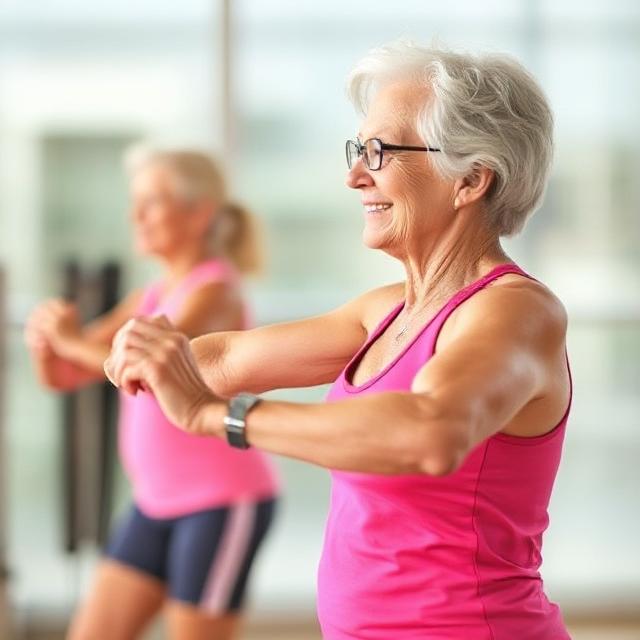Refreshing your workout routine after 60 is a fantastic way to maintain vitality, boost energy, and improve overall health. As the body ages, it’s important to adjust your fitness strategies to match new needs and goals, ensuring workouts remain effective, safe, and enjoyable. Changing your routine can help prevent plateaus, reduce the risk of injury, and reignite motivation. By incorporating a variety of approaches—from adapting intensity to exploring new activities—you can keep your fitness journey exciting and sustainable. Here are nine simple yet powerful strategies designed to refresh your workout routine after 60, each explained in detail to inspire your next steps.
1. Embrace Low-Impact Cardio Alternatives
Traditional high-impact cardio workouts like running or jumping may become less appealing or feasible after 60 due to joint sensitivity or risk of injury. Embracing low-impact cardio alternatives such as swimming, cycling, or using an elliptical machine can provide cardiovascular benefits without putting excessive stress on joints. Swimming, for instance, offers a full-body workout that enhances endurance, flexibility, and muscle strength while minimizing impact. Cycling, whether stationary or outdoor, improves heart health, leg strength, and coordination while being gentle on knees and hips. Low-impact cardio also helps with balance and stability, crucial for fall prevention in older adults. By diversifying your cardio workouts with these alternatives, you can sustain aerobic fitness and avoid boredom, keeping your heart healthy and your body moving smoothly. This approach allows gradual intensity adjustments, making workouts adaptable as you progress.

2. Incorporate Strength Training Focused on Functional Movements
Strength training remains essential after 60 to combat muscle loss, enhance bone density, and improve metabolic health. However, shifting focus towards functional movements—exercises that mimic daily activities like squatting, lifting, or reaching—can provide more meaningful benefits. Functional strength training emphasizes balance, coordination, and muscle groups working together, which supports independence and reduces injury risks in everyday life. Simple exercises like bodyweight squats, step-ups, or resistance band rows can be highly effective. Additionally, incorporating weights or resistance bands with manageable loads will promote muscle growth without causing strain. This approach targets real-world strength, improving posture, gait, and overall mobility. Functional strength training also engages your core and stabilizer muscles, which are critical for balance and fall prevention. Tailoring your routine to these movements ensures your workouts are practical and impactful, boosting confidence in everyday tasks.

3. Prioritize Flexibility and Mobility Work
Flexibility and mobility tend to decrease with age, leading to stiffness, discomfort, and limited range of motion. Prioritizing exercises that enhance flexibility and joint mobility can refresh your routine and help maintain freedom of movement. Activities like yoga, Pilates, or dedicated stretching sessions promote muscle elongation, joint lubrication, and better posture. Gentle yoga routines designed for seniors improve balance, breathing, and mindfulness, contributing to mental and physical wellness. Incorporating dynamic stretches before workouts and static stretches afterward can improve circulation and reduce muscle soreness. Mobility drills targeting hips, shoulders, and spine improve joint function, making daily activities easier and safer. By integrating flexibility and mobility work, you not only reduce injury risks but also enhance your overall exercise performance and recovery. This balanced focus helps you move more comfortably throughout the day and maintain an active lifestyle.

4. Experiment with Interval Training at a Comfortable Pace
Interval training, which alternates periods of higher intensity with recovery, can be adapted for older adults to boost cardiovascular fitness and metabolism efficiently. Instead of pushing to extremes, choose comfortable intensity levels that challenge you without causing excessive fatigue or injury risk. For example, alternate one minute of brisk walking with two minutes of slower walking, or combine moderate cycling with easy pedaling. Interval training stimulates the heart, improves endurance, and burns calories more effectively than steady-state cardio alone. It also keeps workouts engaging and time-efficient, perfect for busy schedules. You can adjust interval durations and intensities as fitness improves. This strategy helps break monotony and counters age-related declines in aerobic capacity. Listening to your body during intervals is key—always prioritize proper form and avoid overexertion. By experimenting with intervals tailored to your comfort zone, you can reap significant fitness benefits while enjoying variety.

5. Add Balance and Stability Exercises
Maintaining balance and stability is crucial as we age to prevent falls and maintain independence. Adding specific exercises to your routine that focus on these areas can dramatically improve coordination, proprioception, and core strength. Simple balance activities like standing on one leg, heel-to-toe walking, or using a balance board strengthen the muscles and nervous system pathways responsible for stability. Tai Chi and certain yoga poses also improve balance by incorporating slow, controlled movements that enhance body awareness. A stronger core and better postural control reduce the likelihood of falls and help with smooth, confident movement. Regular balance training can be seamlessly integrated into your existing routine or practiced separately. Consistency is key, as improvements may take weeks but are well worth the effort. This focus not only protects your physical health but also boosts confidence in everyday life, empowering you to stay active and adventurous.

6. Incorporate Mind-Body Practices for Mental and Physical Health
Mind-body exercises, such as meditation, mindfulness, and gentle yoga, offer unique benefits for those over 60 by blending physical movement with mental focus. These practices reduce stress, improve sleep, enhance cognitive function, and foster emotional well-being—all vital for healthy aging. Gentle yoga routines improve flexibility and strength while promoting relaxation and breath control. Mindfulness meditation can reduce anxiety and improve concentration, making it easier to stay motivated with your fitness goals. Tai Chi is another excellent option, combining slow, deliberate movements with mental focus to improve balance, strength, and mental clarity. Incorporating mind-body practices into your workout routine refreshes your approach by nurturing both your body and mind. These activities can complement more intense workouts or serve as restorative sessions on rest days. Engaging your mind alongside your body creates a holistic wellness routine that supports longevity and quality of life.

7. Set Realistic, Personalized Goals to Stay Motivated
After 60, setting realistic and personalized fitness goals is a powerful way to stay motivated and make progress meaningful. Instead of focusing solely on weight loss or speed, consider goals that emphasize functional improvements such as walking longer distances, mastering a new yoga pose, or improving balance. Personalized goals help you track progress, celebrate small wins, and maintain a positive mindset toward fitness. They also encourage consistency by providing clear targets tailored to your abilities and interests. Reassessing goals periodically ensures they remain challenging yet achievable, preventing frustration or complacency. Writing goals down or sharing them with a workout buddy can increase accountability. Emphasizing quality of life improvements—like feeling stronger or more energetic—makes the fitness journey rewarding beyond just numbers. By setting thoughtful, individualized goals, you create a sense of purpose and excitement that keeps your workout routine fresh and motivating.

8. Explore New Activities to Stimulate Both Body and Mind
Refreshing your routine by exploring new physical activities can reinvigorate your workout and provide fresh challenges. Trying dance classes, water aerobics, hiking, or even recreational sports introduces novelty that engages different muscle groups and cognitive skills. New activities promote neuroplasticity by requiring coordination, balance, and mental focus, which are crucial for healthy aging. Dancing, for example, combines cardiovascular exercise with rhythm and social interaction, boosting mood and brain function. Water aerobics offers a supportive environment that reduces joint stress while providing resistance. Hiking connects you with nature, improving cardiovascular health and mental well-being simultaneously. Exploring diverse activities prevents boredom, reduces overuse injuries, and encourages lifelong learning. These experiences also provide social opportunities, which enhance emotional health. By stepping outside your usual routine, you challenge your body and mind in enjoyable ways, contributing to overall vitality and happiness.

9. Focus on Recovery and Listen to Your Body
As we age, recovery becomes as important as the workout itself. Focusing on proper recovery strategies—like adequate sleep, nutrition, hydration, and rest days—ensures your body can repair and strengthen after exercise. Ignoring recovery increases the risk of injury, fatigue, and burnout. Listening to your body’s signals such as persistent soreness, joint pain, or unusual fatigue is essential. Adjust workout intensity or take extra rest as needed without guilt. Incorporating restorative activities like gentle stretching, foam rolling, or massages can accelerate recovery and reduce muscle stiffness. Paying attention to recovery enhances workout effectiveness, helps maintain consistency, and supports long-term fitness goals. Recovery also includes managing stress and mental health, which influence physical performance. By prioritizing recovery and respecting your body’s limits, you create a balanced fitness routine that promotes sustainability, enjoyment, and overall well-being well into your later years.

Refreshing your workout routine after 60 is not just about changing exercises but about embracing a balanced, mindful, and adaptable approach to fitness. By combining cardiovascular health, strength, flexibility, balance, and mental wellness, you nurture your entire body and mind. This holistic approach keeps your routine exciting, sustainable, and aligned with your evolving needs. Embracing variety, listening to your body, and setting meaningful goals empower you to enjoy an active, fulfilling lifestyle. Whether you try new activities or refine existing ones, these strategies ensure your fitness journey remains vibrant and rewarding, helping you thrive at every age.


